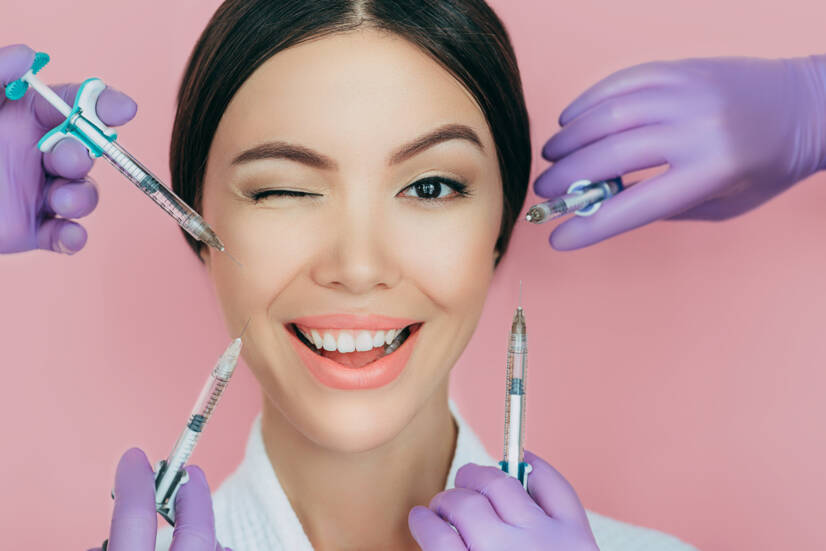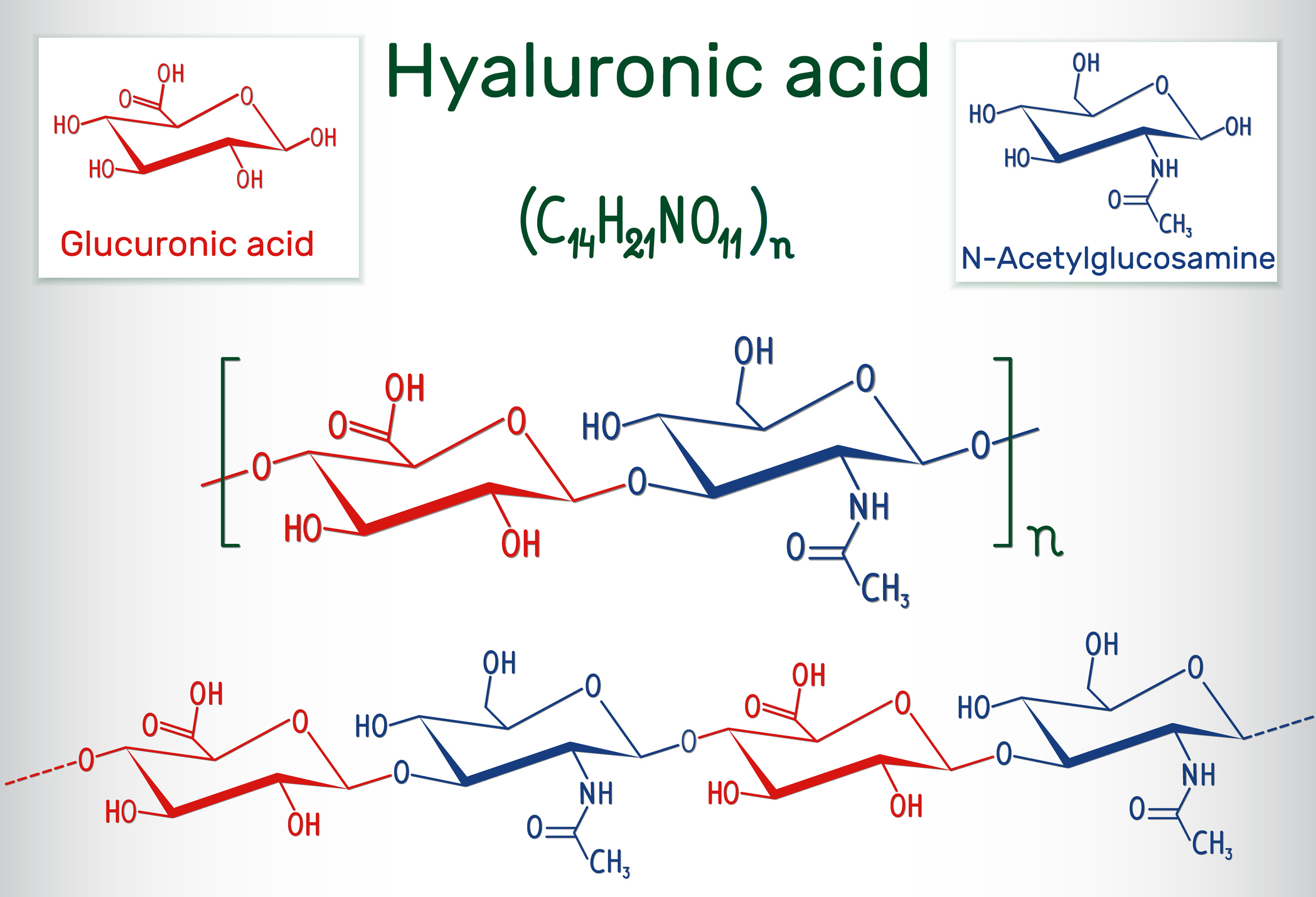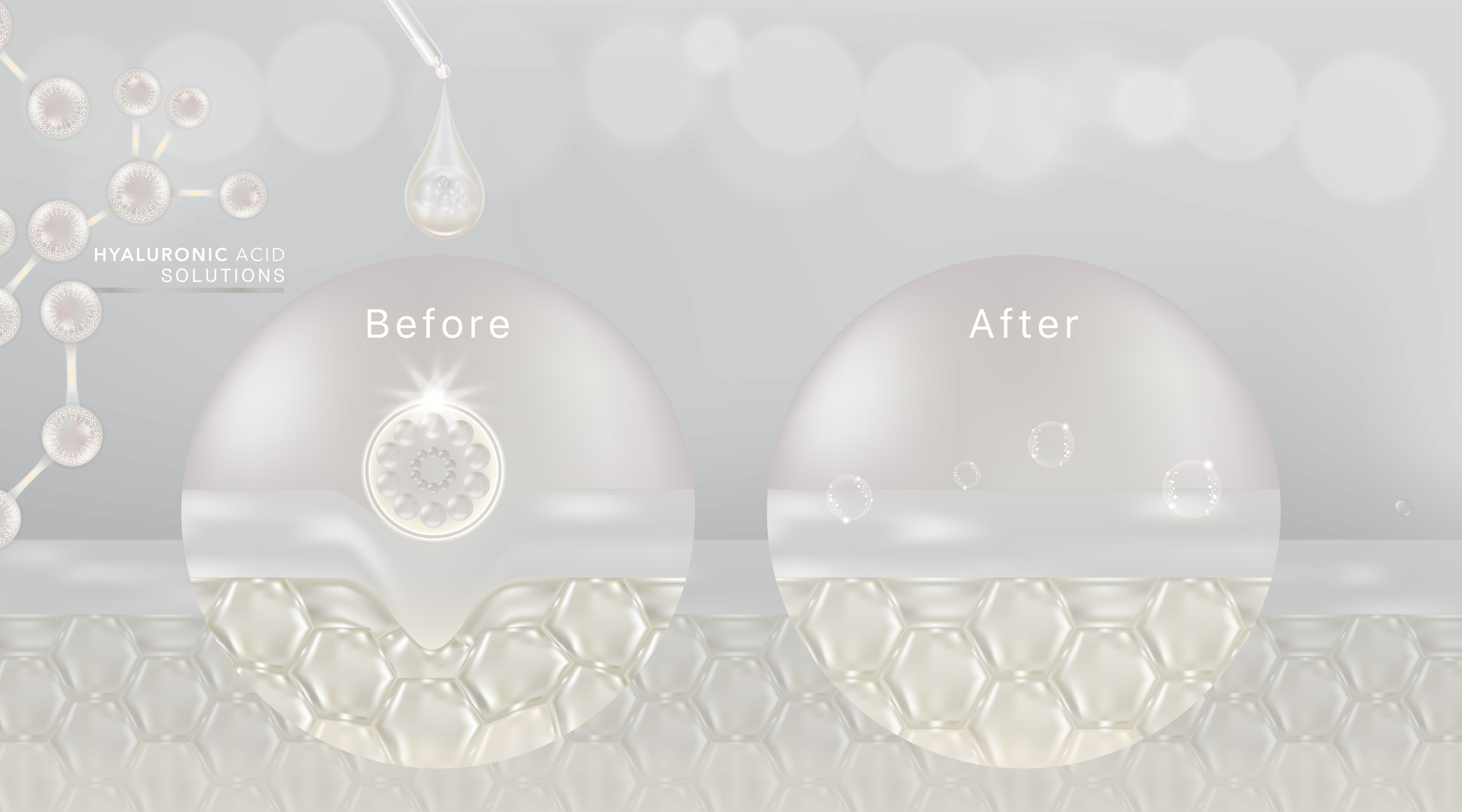- ncbi.nlm.nih.gov - Kendra Walker; Brandon M. Basehore; Amandeep Goyal; Patrick M. Zito., Hyaluronic Acid
- pubmed.ncbi.nlm.nih.gov - Abatangelo, V. Vindigni; G. Avruscio; L. Pandis, Brun4, Hyaluronic Acid: Redefining Its Role
- ncbi.nlm.nih.gov - Abatangelo, V. Vindigni, G. Avruscio, L. Pandis, and P. Brun, Hyaluronic Acid: Redefining Its Role
- ncbi.nlm.nih.gov - Liane Bolke, Gerrit Schlippe, Joachim Gerß, and Werner Voss, A Collagen Supplement Improves Skin Hydration, Elasticity, Roughness, and Density: Results of a Randomized, Placebo-Controlled, Blind Study
- ncbi.nlm.nih.gov - Arely León-López, Alejandro Morales-Peñaloza, Víctor Manuel Martínez-Juárez, Apolonio Vargas-Torres, Dimitrios I. Zeugolis, and Gabriel Aguirre-Álvarez, Hydrolyzed Collagen-Sources and Applications
Hyaluronic acid and its effects on the skin and musculoskeletal system?

Photo source: Getty images
Hyaluronic acid and collagen - the key to an eternally young appearance? It will help your joints and find other uses...
Article content
What is hyaluronic acid and how does it affect the skin and musculoskeletal system?
Skin.
Although it may not seem like it, the skin is the largest organ of our body. Its main structural components are elastic collagen fibres and hyaluronic acid. Healthy skin forms the boundary between the internal environment of our body and the external environment. It protects the body from external damage. It regulates body temperature, but also performs other functions of our body.
Another area where it has an irreplaceable place is the musculoskeletal system and joints.
Where is it important and why?
Hyaluronic acid - what is it and what does it look like?
Everyone has heard of hyaluronic acid, but do you know what it looks like and what it's made of?
Hyaluronic acid is a polysaccharide. The term poly means that it is made up of a large number of identical units. In this case, a disaccharide (which is made up of N-acetylglucosamine and D-glucuronic acid). This is where the prefix poly and saccharide come from.
These disaccharide units repeat and combine countless times to form the incredibly important molecule hyaluronic acid.

Hyaluronic acid is found naturally in a large number of organs in our bodies. And even more interestingly, not just in the human body.
This molecule is neither species nor tissue specific. That is, it is the same in its pure form in all organisms. Therefore, when applied, it produces almost no immune reaction.
The body of a 70 kg person contains 15 g of hyaluronic acid. Even more interestingly, 5 g of this amount is replaced daily.
Hyaluronic acid is naturally and constantly renewed. This is due to its rapid degradation. Its renewal slows down with age, but also due to the external environment.
Hyaluronic acid and ageing
With aging, cells lose their ability to produce hyaluronic acid.
The consequence of this process is that the skin becomes:
- drier
- thinner
- looser
This leads to the formation of wrinkles. Similarly, skin hydration decreases with age.
So where is hyaluronic acid found everywhere?
It can be found, for example, in:
- Skin
- eyes
- connective tissue
- synovial fluid in the joints
Hyaluronic acid is involved in many processes in our body, including:
- cell differentiation
- embryological development
- inflammation
- wound healing
- viscoelasticity and more
Hyaluronic acid has the ability to bind water to itself, up to 1000 times its volume.
Hyaluronic acid and its effects
When you say hyaluronic acid, most of us think of its cosmetic uses in lip augmentation and wrinkle smoothing. Injections containing hyaluronic acid are applied to restore volume, facial contours and to restore or maintain a youthful appearance.
However, hyaluronic acid-based injections differ in the following parameters:
- hyaluronic acid concentration
- particle size
- cross-linking density
- the presence of lidocaine - a local anaesthetic added to reduce pain during injection
Preparations with high density and large particles are suitable for deep dermal injections. On the other hand, preparations with low density and small particles are recommended for fine wrinkles.
However, the fillers used in the cosmetic industry do not contain exactly the same acid that is in our bodies. These injections contain modified hyaluronic acid particles. As a result, the acid is:
- more concentrated
- and is more resistant to chemical and physical degradation
As the hyaluronic acid degrades, it is slowly replaced by water. Although the hyaluronic gel is less concentrated, it still occupies the same volume. This process is called "isovolumetric degradation".
And how long is the "effect" of these fillers?
The length of the resulting effect depends on the specific brand, the injection technique, but also on the site where it is injected. On average, it varies between four and six months.
And why are hyaluronic acid fillers so popular?
First of all, because they have many undeniable advantages:
- They cause a low allergic reaction
- They are easy to apply
- Recovery from the procedure is fast
- Results are visible immediately
- And they are always achievable again.
But how is it actually able to "fill" wrinkles?
Thanks to its properties, it can attract water. This creates the necessary volume that can smooth wrinkles.
Unfortunately, ageing reduces the production of hyaluronic acid and also collagen in the skin. These fillers therefore have an anti-ageing effect. Not only do they replace lost volume, but they can also increase collagen production.
Hyaluronic acid and its use as a cream or serum
It seems almost unbelievable, but hyaluronic acid has been used in the cosmetic industry for more than 20 years.
Hyaluronic acid and its derivatives can be found in a huge number of cosmetic products.
They can be found, for example, in products intended for:
- eye area
- lips
- face and neck
- but also in anti-cellulite products
As regards the use of hyaluronic acid in the form of creams, lotions, masks or serums, its anti-wrinkle effect has not been scientifically proven. It should also be noted that the effects of hyaluronic acid depend largely on its molecular weight.
However, its moisturizing effect may optimize the penetration of the active substances into the different layers of the skin. However, the exact mechanism of transdermal transport of hyaluronic acid is still unclear.
The visible effect of creams and serums with hyaluronic acid is probably due to the fact that hyaluronic acid binds water molecules to itself when applied to the face. This makes the skin more hydrated and also more elastic.

As described above, hyaluronic acid may assist in the absorption of other active ingredients from the product.
Various plant extracts may therefore provide effects:
- antioxidant
- anti-inflammatory
- hydrating
- strengthening
- anti-wrinkle
- whitening
- photoprotective
If the product contains plant extracts, adverse allergic reactions may occur.
In addition to plant extracts, other active ingredients may be present in the products.
Some of the most common include:
- Probiotics
- amino acids
- peptides
- proteins
- vitamins
- carbohydrates
- lactic acid
- urea
- allantoin
- or even gold
Even these active substances have a rich spectrum of effects:
- moisturizing
- slow down aging
- antioxidant
- keratolytic
- skin lightening
- depigmenting
These active ingredients are considered safe for use in cosmetic products. They are generally well tolerated. Of the side effects, contact dermatitis is the most common.
When it comes to the marketing of hyaluronic acid, the old familiar equation applies. Consumers attribute high value and therefore efficacy to a product with a higher price. Premium cosmetics usually include products with a higher purchase price.
Interestingly, sunscreens containing hyaluronic acid help to maintain firmer skin while protecting it from the harmful effects of UV rays, all thanks to the potential antioxidant effect of HA.
Side effects
Hyaluronic acid produces almost no immune reaction. Nevertheless, some of the following side effects may occur after its application.
Some of the most common include:
- Pain
- bruising
- redness
- itching
- and swelling, especially at the site of application
These symptoms do not last more than seven days.
After the injection, the patient should apply a cold compress to the injection site to minimise bruising and swelling. They should also avoid moving in the treated area for a period of time.
It is also advisable to discontinue medications and dietary supplements that increase the risk of bleeding for at least one week before the procedure.
These include:
- Acetylsalicylic acid - available in several over-the-counter pain and fever medications
- non-steroidal anti-inflammatory drugs
- vitamin E
- fish oil
- St John's wort
- ginkgo biloba
Extremely rare but all the more serious side effects include:
- Infections
- tissue necrosis
- granulomatous reaction to a foreign body
- activation of herpes labialis
Infection is caused by the penetration of bacteria through the injection site. Therefore, sterile performance of the procedure is very important. It is equally important to ensure that there is no active infection around the injection site.
If you have an inflamed area on your face, it is better to postpone such procedures for some time. They could cause you more discomfort than pleasure.
Necrosis is particularly likely to occur if the hyaluronic acid gel is injected intra-arterially. Therefore, knowledge of the facial anatomy is extremely important during application. A blood aspiration test should also be performed before injection.
If this unpleasant situation has already occurred, hyaluronidase should be injected as soon as possible. It is an enzyme that breaks down both native and injected hyaluronic acid.
Granulomatous reaction to a foreign body is very rare. It is probably caused by a reaction to bacterial contaminants that have entered the product during manufacture. However, the purification process has improved considerably in recent years. This reaction is therefore very rare indeed.
When applying to the lips, it is necessary to check whether the patient is suffering from the herpes simplex virus. Alternatively, the patient may have reactivated herpes simplex after a previous application of hyaluronic acid.
This disease can be treated with orally applied acyclovir.
Hyaluronic acid and its other uses
Although injectable fillers are one of the most commonly performed procedures, hyaluronic acid has many more uses in our bodies.
One of the uses of this acid is its application to joints in arthritis. The reason for its use is very similar to that of cosmetic use.
Hyaluronic acid occurs naturally in synovial fluid. (Synovial fluid is also popularly called joint sebum. Its role is primarily to reduce friction of cartilage and bone in the joint during movement).
Unfortunately, in osteoarthritis, its quantity decreases. As a result, the viscosity of the synovial fluid is reduced.
It is mainly used for pain relief. Its application has become popular especially as a non-surgical treatment method.
Hyaluronic acid is degraded within a few hours after its application to the joint. Preparations with synthesized hyaluronic acid with a high molecular weight degrade more slowly.
Although the hyaluronic acid itself breaks down very quickly, the analgesic effect persists for several months.
These intra-articular injections can stimulate the sites that naturally produce hyaluronic acid. Its anti-inflammatory effects have also been demonstrated.
The injections are injected directly into the joint. If there is any effusion in the joint, it should be removed first. Of course, a strict aseptic procedure is essential.
The patient should refrain from intense or prolonged heavy physical activity for at least 48 hours.
As for the side effects of joint injections, they are usually mild and tend to disappear spontaneously.
In 2 % of patients, the following symptoms may occur after injection:
- more pain
- swelling
- redness
- warmth
These problems can be addressed by applying ice packs and, if necessary, by administering anti-inflammatory drugs.
Hyaluronic acid is also used to promote healing of wounds and ulcers. In this case, it is recommended to clean the wound before applying it. A thin layer of the product is applied to the wound or ulcer. Excessive friction should be avoided. The wound is then covered with a sterile dressing.
Hyaluronic acid is also a common ingredient in products designed to moisten the eye, called artificial tears. These products are used in dry eye syndrome.
Finally, we come to the oral forms of hyaluronic acid. Recently, various forms have appeared on the market. These are mainly tablets or powders.
Hyaluronic acid has a rapid half-life. In the skin, it takes between 12 and 24 hours. In the bloodstream, it breaks down within a few minutes.
If hyaluronic acid were absorbed from our digestive tract, it would rapidly break down in the lymph nodes and liver.
Outside the cell, hyaluronic acid is degraded by, for example, hyaluronidase, reactive oxygen species, superoxide and other substances that are produced mainly during inflammation.
Therefore, I personally would not attribute any effect to oral preparations.
Collagen
Collagen is the most abundant protein in our skin. Studies have shown that in young and healthy skin its content exceeds 75%.
Collagen has the appearance of a rope - three chains wind around each other to form a collagen triple helix. These then join together to form collagen fibrils.
Incredible as it may seem, 28 types of collagen have been identified. Collagens differ according to the composition of the α-chain.
Type I collagen is most commonly found in:
- skin
- bone
- teeth
- tendons
- ligaments
- vascular connections
Type II collagen contains mainly:
- cartilage
Type III collagen is most commonly found in:
- skin
- muscles
- blood vessels
Its most important role is to maintain the structure of the skin. However, it also enables it to perform many functions. Healthy skin forms the boundary between the internal environment of our body and the external environment.
Skin aging is also associated with collagen loss. Collagen loss begins between the ages of 18 and 29. After the age of 40, the body loses approximately 1% of collagen per year. And around the age of 80, production is 75% lower compared to young adults.
However, this process is accelerated by many different factors:
- sunlight
- smoking
- environmental pollution
- Alcohol
- unbalanced diet
- diseases
- micronutrient deficiencies caused by stress
As a result, the elasticity decreases, leading to the formation of wrinkles and lines on the skin. As a result of the loss of collagen, the skin also becomes thinner and drier.
The good news is that we can supply our bodies with collagen by consuming specific bioactive collagen peptides.
These are obtained by enzymatic hydrolysis
- of natural bovine collagen
- or natural pork collagen
But research also points to the good properties of collagen found in the skin, scales and bones of marine animals.
The specific collagen peptides are further metabolised in our digestive system to form smaller units - bioactive di- and tripeptides - which are then transported through the bloodstream to the skin where they accumulate.
Collagen preparations are composed of peptides of different lengths. They are also characterised by a particular amino acid composition. The composition depends on the source from which they are prepared.
Cleaved collagen acts in two ways:
- the amino acids serve as building blocks for the formation of new collagen and elastin fibres
- the oligopeptides can bind to fibroblast membranes and thus stimulate the production of new collagen, elastin and also hyaluronic acid
Consumption of these products improves the physiology and appearance of the skin. Hydrolyzed collagen is able to reach the deeper layers of the skin, increasing its hydration, elasticity and firmness. It acts to reduce wrinkles with a resulting effect of skin rejuvenation.
Studies have shown significant improvements in skin hydration, wrinkles and elasticity in women aged 40 to 60 years. Oral treatment with hydrolysed collagen lasted 12 weeks.
Another study showed improvements in skin density, firmness and elasticity during a three-month treatment in women aged 35 to 65.
Another study showed a protective effect on joints in addition to improving skin texture and elasticity.
However, collagen has other important functions in our bodies.
For example, it helps with:
- organ development
- wound and tissue healing
- repair
- cornea
- gums
- bone
- or blood vessels
It is also important for biological functions of the cell, such as:
- the formation of new cells
- survival
- differentiation
Aging is a natural process that involves changes in our bodies. The appearance and texture of the skin changes, the amount of hyaluronic acid, collagen and elastin decreases.
Controlling or slowing down this process is therefore a major challenge for the cosmetics industry.
Interesting resources
Related

PharmDr. Mária Horáková
Doctor of Pharmacy
I studied pharmacy at the University of Veterinary Medicine and Pharmacy in Košice. Subsequently, I obtained my PharmDr. degree at the University of Veterinary and Pharmaceutical Sciences in Brno. Alongside my studies I worked in a public pharmacy. After two years of maternity leave, I took up the position of a pharmacist in a pharmacy. At the same time I am completing my specialisation studies in pharmacy.
Since every day in my work I encounter various questions about diseases and over-the-counter medicines, nutritional supplements, and I am the type of person who likes to educate myself, I am very glad that I got the opportunity to solve some problems in this way as well.
View all articles by the same authorThe aim of the portal and content is not to replace professional
examination. The content is for informational and non-binding purposes
only, not advisory. In case of health problems, we recommend seeking
professional help, visiting or contacting a doctor or pharmacist.









